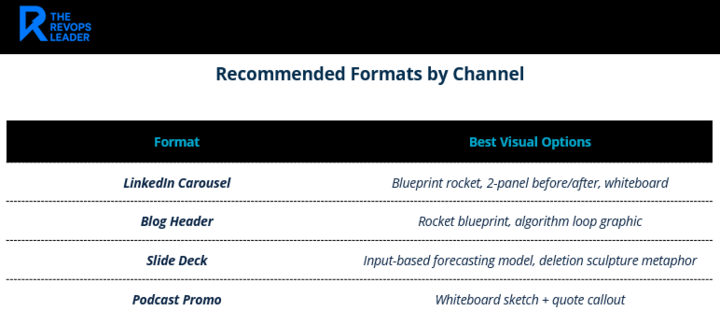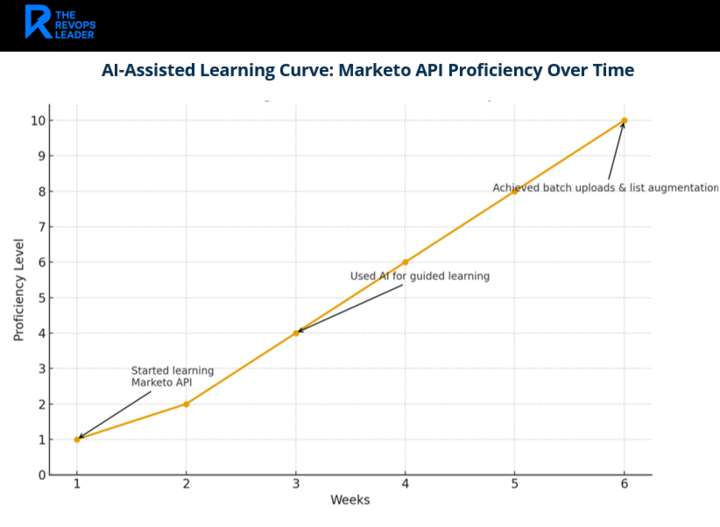Kill the Lead Object. Save Your CRM
In this issue:
What if you approached RevOps like an aerospace engineer?
Why transition to a customer-centric CRM model, and how to leverage AI properly
How leads went from sitting for 2-3 days to getting worked on in minutes through simple automation
1. What if you approached RevOps like an aerospace engineer?
Boardroom RevOps podcast by AccountAim, Episode: The RevOps Success Algorithm, with Oscar Armas-Luy, VP of RevOps at Garner Health (Nov. 14, 2025)
TLDR:
Oscar Armas-Luy applies a five-step engineering algorithm to every RevOps initiative: question requirements, delete non-value steps, simplify, accelerate, then automate
The framework prevents wasted work by eliminating unnecessary requirements before teams start building
The five-step algorithm written on Oscar’s whiteboard
Oscar keeps a framework on his whiteboard 24/7. It's attributed to Elon Musk, and it has five steps that run in order:
question every requirement
delete any part of the process that doesn't add value
simplify and optimize
accelerate cycle time
automate
The order matters. Most teams jump straight to automation, but that just makes bad processes faster. "If you can really see where a requirement came from or what they're after, you can tweak the requirement a little bit," Oscar explained. The goal is to reduce unnecessary work before you start building anything.
Why questioning requirements isn't pushback
The first step – questioning requirements – could make you seem difficult if done wrong. Oscar approaches it from curiosity, not confrontation. When someone says "the CEO wants it this way," he asks why. What outcome are they actually trying to achieve?
Senior leaders aren't in the day-to-day details, so their requests often get taken too literally. By understanding the real goal, you can often find a better, simpler solution.
Deletion is the hardest and most important step
Most people think innovation means adding more: more features, more steps, more automation. But innovation often comes from subtraction. "It is very difficult to remove something from a process unless you understand the process really clearly," Oscar noted.
This requires documentation, even if it's rough. Map out your current process, then identify which steps actually create value. The problem is that people get emotionally attached to what they've built, which is why new team members often spot opportunities that veterans miss.
First-principles forecasting changes everything
Most sales teams forecast by working backward from their target. Oscar takes a different approach: forget the quota and start with first principles. What are the actual inputs that drive results?
For each rep and team, he maps controllable inputs – meetings taken, demos delivered, outreach volume – then uses historical data to understand how those inputs convert to outcomes.
"This type of forecasting is a lot simpler, a lot less subjective, and you can almost entirely automate it once you've got it defined," he said.
The Bottom Line
Before building anything, question whether you need all those requirements. Delete steps that don't add value. And build systems that tell people what to do, not just what happened.
2. Why transition to a customer-centric CRM model, and how to leverage AI properly
RevOps Co-op, Webinar: Unblock Your Data Model, Unlock Your Revenue: How to Break the CRM Data Bottleneck (Nov. 16, 2025)
TLDR:
Most CRMs can't answer basic questions like "Who are our customers?" because data lives in PDFs and email, not structured fields
The lead object in your CRM should be eliminated in favor of a contact-centric data model that follows the actual customer journey
Even with AI, you still need structured data: chatbots aren't reliable enough for counting or reporting yet
Here's a simple test: open your CRM and try to get a list of all your customers. Not opportunities, not accounts – actual customers with their contract start dates, end dates, and which products they're using. If you're struggling, you're not alone.
The C in CRM stands for customer but customers aren't there
Rob Moseley from GTM Engine frames the problem: "The C in CRM stands for customer. Can anybody reliably do the most basic thing and tell you who your customers are and what products they're using?" For most companies, that data lives in PDF contracts, not the CRM.
This isn't just an inconvenience. When different teams use different versions of the truth, everything breaks. Marketing doesn't know which use cases resonate. Sales can't figure out what was promised during the deal. Customer success teams ask, "Why are they buying from us?" And nobody has a clear answer because the data is scattered across tools, documents, and tribal knowledge.
Why the “lead” object needs to die
The traditional CRM model treats leads and contacts as separate objects. A person starts as a lead, then converts to a contact attached to an account and opportunity. But this creates a fundamental problem: you lose the ability to track the full customer journey.
"The lead object should die and be replaced with a contact-centric model," the panel agreed. In a contact-centric model, you track people from their first interaction all the way through to customer, renewal, and expansion. You can see the entire relationship history instead of having it fragmented across objects.
Structured data still matters, even with AI
Many teams think AI will solve their data problems. Just point a chatbot at your messy data and ask questions, right? Not quite. "They're really not good at counting," Jared Barol noted from his experience. "You'd upload a document and ask how many mentions of something appeared, and the chatbot would give different answers each time."
The reality is that reports need structured fields – booleans, pick lists, dates, numbers. These enable reliable comparisons and analysis. AI can help generate that structure from unstructured data (emails, calls, tickets), but you still need to store it in reportable formats.
Context windows aren't large enough yet, and costs aren't low enough, to reliably analyze massive amounts of unstructured data.
From signals to structure
The solution is capturing unstructured data (conversations, support tickets, email threads) and using automation to create structured fields from that information. For example, a call transcript can automatically populate fields about budget discussed, decision timeline, and key objections.
This approach gives you the best of both worlds: you preserve the rich context of unstructured data while creating reportable fields that enable analysis. And if you need to ask new questions later, you can replay your stored unstructured data to generate new structured fields.
The Bottom Line
Your CRM's job is to track customers, but most can't do it because the data model is wrong. Kill the lead object, move to contact-centric tracking, and use automation to turn unstructured signals into structured data.
3. How leads went from sitting for 2-3 days to getting worked on in minutes through simple automation
Marketing Insider Series by Mavlers, Episode: AJ Navarro on Smarter RevOps, Cleaner Data, Faster Leads (Nov. 11, 2025)
TLDR:
Speed-to-lead is the most overlooked RevOps metric: AJ reduced handoff time from 2-3 days to minutes by fixing alerts and workflows
Building a unified GTM engine requires bringing stakeholders together first, then choosing tools that serve everyone
AI amplifies your skills when used strategically, not as a shortcut: AJ taught himself Marketo API through AI in weeks
Speed-to-lead is everything
The biggest problem AJ discovered wasn't bad data or wrong tools – it was time. In one organization, leads would sit for 2-3 days before anyone touched them. Why? There were no alerts set up. Or if there were, they went to the wrong people. Nobody was tracking how quickly leads got worked.
AJ's solution was ruthless simplicity: set up system alerts for every new lead. But he took it further: if a buying stage doesn't change within 24-48 hours, he sends himself an alert. Not to micromanage, but to understand if leads are actually getting worked. This created visibility that didn't exist before.
The result? Lead handoff time dropped from days to minutes! When you remove friction between marketing creating a lead and sales working it, revenue velocity increases dramatically.
The hardest part of building a unified GTM engine isn't the technology
When AJ led a Six Sense implementation for a national HR services provider, the first challenge wasn't technical, it was human. He had to get marketing, sales, and RevOps leaders in the same room and get them to agree on what mattered.
This is harder than it sounds. Marketing cares about lead volume. Sales cares about deal velocity. Finance cares about forecast accuracy. Getting alignment means forcing uncomfortable conversations about whose metrics actually drive business outcomes.
Only after that alignment did AJ focus on technology. The architecture was straightforward: connect the marketing automation platform, CRM, and intent data tool into one unified system. But the technology only worked because everyone agreed on the goal first.
Use AI to amplify your skills, not replace your thinking
AJ uses AI as what he calls his "Jarvis system" – a strategic partner, not a shortcut. For example, when building campaigns, he asks AI to develop multi-touch campaigns with specific CTAs and guardrails. When preparing proposals, he uses jobs-to-be-done prompts: "Give me the top 10 buyer pain points for someone considering a new marketing automation platform."
The key? He always asks why the AI gave that answer and validates the sources. AI is only as good as what you feed it and how you train it over time.
AJ taught himself the Marketo API in weeks using AI, despite having zero coding experience. He's now doing advanced batch uploads and list augmentation through the API – work that would have required hiring a developer a few years ago.
Disclaimer
The RevOps Leader summarizes and comments on publicly available podcasts for educational and informational purposes only. It is not legal, financial, or investment advice; please consult qualified professionals before acting. We attribute brands and podcast titles only to identify the source; such nominative use is consistent with trademark fair-use principles. Limited quotations and references are used for commentary and news reporting under U.S. fair-use doctrine.


